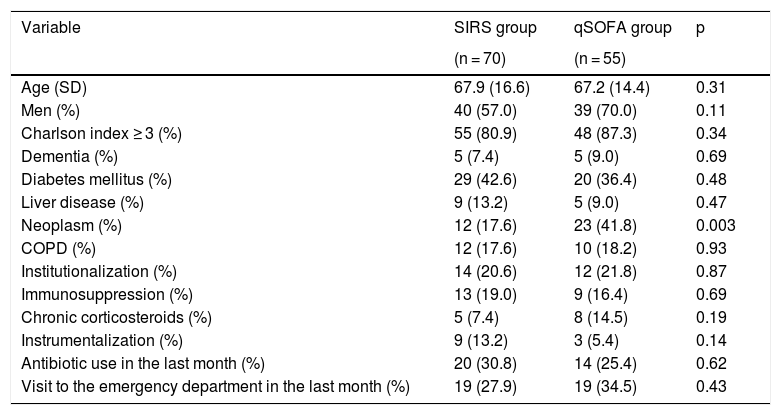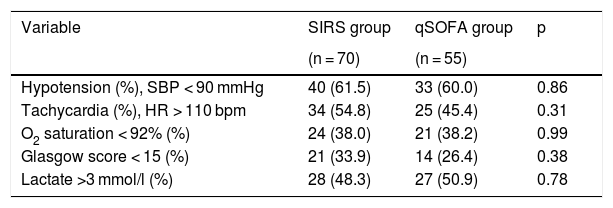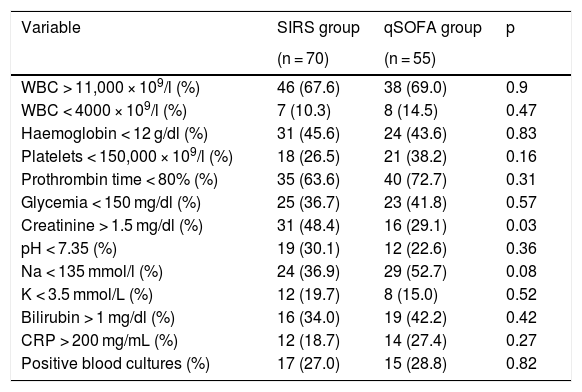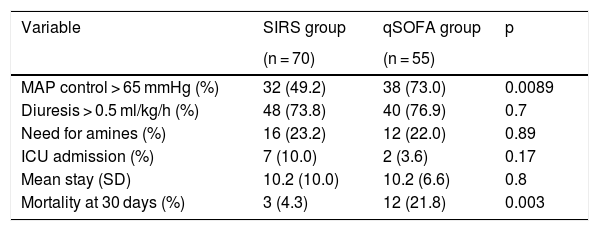The early diagnosis and treatment of sepsis remains a challenge in hospital emergency departments.
ObjectiveThe objective was to evaluate the performance of the qSOFA (quick Sequential related Organ Failure Assessment) for activating a Sepsis Code in the emergency department, compared to applying previous criteria based on SIRS (Systemic Inflammatory Response Syndrome).
MethodsPatients ≥18 years were included who consulted an emergency department of a tertiary hospital over two periods of time (May–October 2015), using SIRS criteria (SIRS Group) and over the same months in 2017 using qSOFA criteria (qSOFA Group).
ResultsOne hundred and five episodes were analysed: 70 corresponded to the SIRS Group and 55 to the qSOFA Group. The groups were comparable in terms of history, with a greater presence of neoplastic disease in the qSOFA Group. No differences were observed in the form of presentation, the action taken in the emergency department, admissions to critical care units, use of vasopressors or mean hospital stay between the two groups. A higher 30-day mortality rate was observed in the qSOFA group (21.81% vs. 4.3%; P = 0.003). In the multivariate study, neoplastic disease was noteworthy as an independent factor of poor prognosis (OR 5.36; P = 0.01), and activation using the SIRS criteria as a factor of good prognosis (OR .15; P = 0.021).
ConclusionsThe activation of the Sepsis Code using qSOFA criteria results in a reduction in detection, with greater associated mortality. Other complementary tools need to be sought for the early detection of sepsis in the emergency department.
El diagnóstico y el tratamiento precoces de la sepsis sigue siendo un reto en los servicios de urgencias hospitalarios.
ObjetivoEl objetivo es evaluar el rendimiento de la escala quick Sequential related Organ Failure Assessment (qSOFA) para la activación de un Código Sepsis en urgencias, respecto la aplicación de los criterios previos basados en los parámetros Systemic Inflammatory Response Syndrome (SIRS).
MétodosSe incluyeron los pacientes ≥18 años que consultaron en un servicio de urgencias de un hospital de tercer nivel durante dos períodos de tiempo (mayo-octubre de 2015) mediante criterios SIRS (grupo SIRS), y en los mismos meses de 2017 mediante criterios qSOFA (grupo qSOFA).
ResultadosSe analizaron 125 episodios: 70 correspondieron al grupo SIRS y 55 al grupo qSOFA. Los grupos fueron comparables respecto a antecedentes, con mayor presencia de enfermedad neoplásica en el grupo qSOFA. No se evidenciaron diferencias en la forma de presentación, la actuación realizada en urgencias, los ingresos en unidades de críticos, el uso de vasopresores o la estancia media hospitalaria entre los dos grupos. Sí se objetivó una mayor tasa de mortalidad a 30 días en el grupo qSOFA (21,81% vs 4,3%; p = 0,003). En el estudio multivariado destaca la enfermedad neoplásica como factor independiente de mal pronóstico (OR: 5,36; p = 0,01), y la activación mediante criterios SIRS como factor de buen pronóstico (OR: 0,15; p = 0,021).
ConclusionesLa activación del Código Sepsis mediante criterios qSOFA comporta una disminución en la detección, con mayor mortalidad asociada. Es necesario buscar otras herramientas complementarias para la detección precoz de la sepsis en urgencias.












